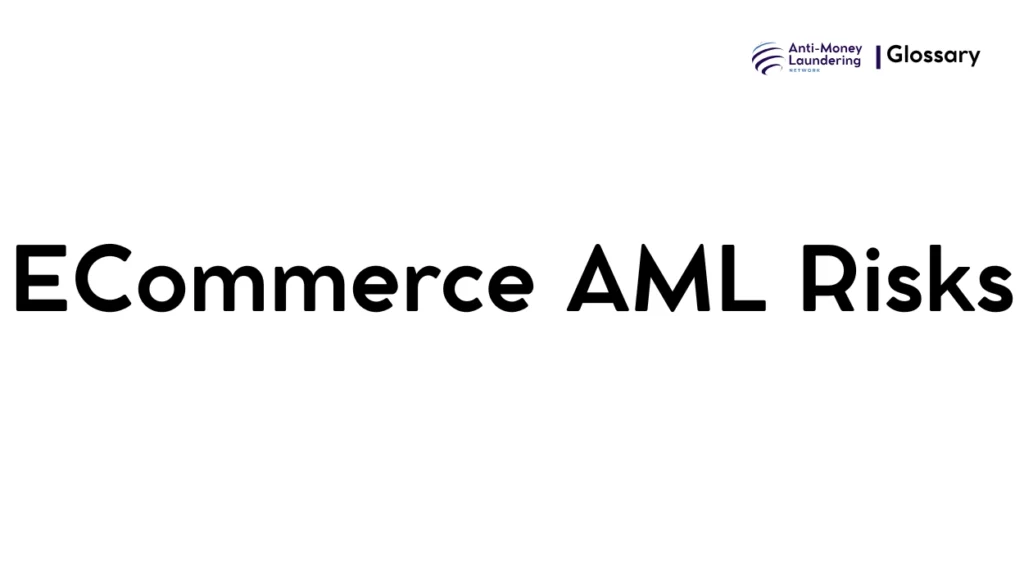Definition
In Anti-Money Laundering (AML) context, eCommerce AML Risks refer to the specific vulnerabilities and threats associated with online commercial transactions that may facilitate money laundering or terrorist financing. This encompasses risks arising from digital payment methods, online marketplaces, and electronic fund transfers in the eCommerce ecosystem.
Purpose and Regulatory Basis
The purpose of identifying and managing eCommerce AML risks is to prevent, detect, and mitigate the illicit use of digital commerce channels for laundering proceeds of crime or funding terrorism. Due to the rapid growth of eCommerce and its cross-border nature, it presents unique challenges for AML compliance.
Key regulations that emphasize addressing these risks include:
- FATF Recommendations: Global AML standards urging countries to implement risk-based approaches covering virtual assets and online financial dealings.
- USA PATRIOT Act: Requires financial institutions and businesses to establish AML programs covering digital payment and commerce platforms.
- European Union’s 5th and 6th AML Directives (AMLD5 & AMLD6): Enhance due diligence and regulation for electronic money institutions, and digital payment services in the EU.
These regulations promote transparency, customer due diligence (CDD), and reporting suspicious activities in eCommerce.
When and How it Applies
Real-World Use Cases & Triggers:
- Online marketplaces where sellers can transact anonymously or with limited verification.
- Digital wallets and payment gateways accepting various electronic payment forms.
- Cross-border online sales that complicate jurisdictional oversight.
Triggers for heightened AML scrutiny include large or rapid transactions, multiple small transactions (structuring), accounts linked to high-risk geographies, or use of cryptocurrencies linked to online sales.
Examples:
- A fraudster using stolen credit cards to purchase goods.
- Funds generated through illegal activities laundered via online sales platforms.
Types or Variants of eCommerce AML Risks
- Payment Fraud Risk: Manipulation or misuse of electronic payment systems enabling money laundering (e.g., chargebacks, fake online identities).
- Customer Anonymity Risk: Limited or falsified customer information hampers effective due diligence.
- Geographical Risk: Transactions involving countries with weak AML regimes or known for illicit financing.
- Technological Risk: Use of encrypted or anonymous technologies like cryptocurrencies or peer-to-peer payment systems.
Each variant requires tailored mitigation strategies.
Procedures and Implementation
To manage eCommerce AML Risks effectively, institutions should implement:
- Risk Assessment: Conduct comprehensive and ongoing risk assessments specific to eCommerce activities.
- Know Your Customer (KYC) & Customer Due Diligence (CDD): Verify customer identity and assess risk profiles before onboarding.
- Transaction Monitoring: Use automated systems to detect unusual patterns, high volumes, or suspicious geographies.
- Suspicious Activity Reporting (SAR): Establish protocols for timely reporting of suspected money laundering events.
- Employee Training: Regular AML training focused on digital commerce complexities.
- Technology Integration: Deploy AML software capable of analyzing multi-channel transactional data.
Impact on Customers/Clients
Customers engaging in eCommerce must undergo certain verification processes that may include identity checks, enhanced due diligence for high-risk profiles, and possible transaction monitoring. While these measures protect financial integrity, customers may experience:
- Additional steps in account creation or payment processing.
- Restrictions on transaction sizes or types, especially for new or high-risk accounts.
- Privacy considerations balanced against regulatory requirements.
Transparency and clear communication help maintain trust.
Duration, Review, and Resolution
AML measures in eCommerce are ongoing. Institutions must:
- Review customer profiles and risk assessments periodically.
- Monitor transactions continuously for evolving suspicious patterns.
- Retain records as mandated (often 5-7 years depending on jurisdiction).
- Update controls and procedures to reflect regulatory changes and emerging risks.
Timely resolution of flagged cases with proper investigative follow-up is critical.
Reporting and Compliance Duties
Institutions engaged in eCommerce have the responsibility to:
- Develop and maintain documented AML policies specific to eCommerce risks.
- Report suspicious transactions to relevant financial intelligence units (FIUs).
- Cooperate with regulators and law enforcement in investigations.
- Conduct independent AML audits.
Penalties for non-compliance can include fines, license revocation, and reputational damage.
Related AML Terms
- Customer Due Diligence (CDD): Process of verifying customer identity.
- Suspicious Activity Report (SAR): Report filed when suspicious transactions are identified.
- Know Your Customer (KYC): Procedures for customer identification and verification.
- Enhanced Due Diligence (EDD): Additional scrutiny for high-risk customers or transactions.
These terms interconnect to form a holistic AML framework inclusive of eCommerce.
Challenges and Best Practices
Challenges:
- Rapidly evolving technology and payment methods.
- High volume and velocity of online transactions.
- Difficulty verifying digital identities.
- Cross-border regulatory inconsistencies.
- False positives in transaction monitoring causing operational strain.
Best Practices:
- Implement adaptive, data-driven AML systems.
- Collaborate across industry and regulatory bodies.
- Invest in advanced analytics and machine learning.
- Enhance customer education on AML-related procedures.
- Regularly update training and compliance frameworks.
Recent Developments
Recent trends shaping eCommerce AML include:
- Growth of cryptocurrency and decentralized finance (DeFi) platforms increasing complexity.
- Artificial intelligence and machine learning improving detection capabilities.
- Stricter global AML regulations focusing on virtual assets and non-face-to-face transactions.
- Integration of biometric verification and advanced digital identity solutions.
- Greater focus on environmental, social, and governance (ESG) considerations in AML compliance.
These developments continue to evolve eCommerce AML risk management practices.
Ecommerce AML Risks represent critical vulnerabilities in the fight against illicit financial flows through digital commerce platforms. Compliance officers and financial institutions must understand its multifaceted nature—from regulatory fundamentals to technological challenges—to effectively detect and prevent money laundering. Implementing robust risk assessments, customer verification, and transaction monitoring systems aligned with global standards ensures safer eCommerce environments, protecting both institutions and customers.

